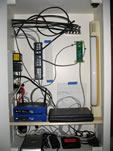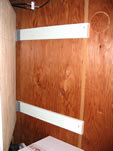My current home automation setup
My home automation setup has evolved since I started about 5 years. It did not happen overnight. At the beginning, I had a vision of what it could become and I am now feeling that I am close to achieving that vision. My vision was centralization. Instead of having various bits of home automation equipment spread throughout the house I wanted everything in one location. Perhaps that came from my experience in the corporate environment relative to telecommunications. Early in my career I spent time designing telecom. rooms.
One of my main governing principles was to keep the cost down. Since this falls in the category of non-essential spending (or at least that’s what my wife thinks) I could not go out and spend thousands on the ultimate solution. So, what you’ll see are sometimes creative ways to get the project done.
Cabinet
A cabinet was key to my centralization approach so it came early on. Also, it was the first area where I decided that costs could be controlled. I looked at some of the commercially available cabinets but they seemed not as flexible as I would like and locked you into a certain line of add-ons as well as being expensive (usually $100 +). So, I built my own from materials I had left over from various home improvement projects. My cabinet is made primarily from 3/4″ plywood. It has enough space for all my gear.
|
Communication cabinet front
|
Communication cabinet front
(note schematic for original plan taped to back) |
For flexibility, it is hung much line a door is. In fact, door hinges are used. This allows me to access all sides of it in order to modify it in virtually any way while not having to remove it from the wall. Removing it from the wall becomes a non-viable option as components are wired into it. Being wood, it also allows me to mount things anywhere avoiding the more rigid mounting systems that metal cabinets have. In fact the shelf was the most recent (and initially unplanned for) addition as the amount of equipment I have has increased.
I mounted a surge protector on the left side of the cabinet to give me plenty of outlets with the added bonus of surge protection for everything. The only problem is that the power supplies for many items have “bricks” that plug into the outlet so they eliminate the possibility of using the outlet next to it. Also, the surge protector is plugged into an outlet which is the only one on the entire circuit.
On the right side, you will see a fluorescent light. Since the cabinet is in a dark corner of my basement, lighting was always an issue. I had this light lying around so I mounted it to the side of the cabinet. Based upon my experience, a fluorescent light near all that unshielded cable cannot be good. Well, the light is only used when I am working in the cabinet. This is rare so the impact is virtually nothing.
Cable TV Distribution
My house had very little coax in it when I started this so I was able to easily go to a star topology and eliminate all of the splitters. The kind of splitter (1:8) used does introduce quite a bit of signal loss but I am using analog cable right now so it is not a factor. My plan is to add an amplifier before the splitter should signal loss become a problem.
For a long time, I used cable for my broadband. When I did, I added a splitter outside of the cabinet to split off the cable signal that went to the cable router to factor out the degradation that the 1:8 splitter might introduce. This also allowed me to use just one filter on the other side of that 1:2 splitter before the cable went to my larger splitter.
Broadband
Within the last few months I went from cable to DSL for my broadband service. It has saved a bunch of money since I went from $45/month (Comcast) to $25/month (SBC DSL Pro). I had both running for a few days and found that by using bandwidth measurements at speakeasy.net, I see that I really have not lost anything in terms of throughput. When I accessed servers that were physically closer, cable was indeed faster (cable’s 4.5 Mbps vs DSL’s 2.0 Mbps) but when I accessed servers that were across the country, the two were very much the same (cable’s 1.4 Mbps vs. DSL’s 1.5 Mbps). Note: these results were achieved using an older PIII 550Mhz machine and with a faster
P4 2.4 Ghz machine bandwidth increased by approximately 33% meaning the bottleneck that prevents achieving the advertised speeds is
not necessarily where you would think it was. In the course of normal use, I don’t notice any difference between cable and DSL.
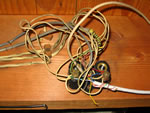 Similar to my approach for centralized filtering with the cable modem, I decided to go with a whole house DSL filter. Mostly governing this decision was my desire to avoid the mess of wiring that makes up my phone system. Unlike the CATV wiring, it has been in the house since it was built and 50+ years of homeowner modifications is not good. I added the DSL filter before the spaghetti of the old phone wiring. The DSL modem is right off the filter so it is running on all new wire since the phone cabling into my house was replaced a couple years ago when a neighbor’s tree service took out my old wiring. Interestingly, when I first got the DSL modem I connected it to the phone extension in my office which did run on the old 50+ year wiring and the bandwidth tests done when it was there were identical to those I did later with the newly wired system.
Similar to my approach for centralized filtering with the cable modem, I decided to go with a whole house DSL filter. Mostly governing this decision was my desire to avoid the mess of wiring that makes up my phone system. Unlike the CATV wiring, it has been in the house since it was built and 50+ years of homeowner modifications is not good. I added the DSL filter before the spaghetti of the old phone wiring. The DSL modem is right off the filter so it is running on all new wire since the phone cabling into my house was replaced a couple years ago when a neighbor’s tree service took out my old wiring. Interestingly, when I first got the DSL modem I connected it to the phone extension in my office which did run on the old 50+ year wiring and the bandwidth tests done when it was there were identical to those I did later with the newly wired system.
Networking
I have a mix between wired and wireless ethernet. About five years ago, before wireless became mainstream, I started with the wired networking. As I added cable TV to rooms, I also ran Cat 5E to the same locations. As a result, I have wired networking to four locations: my office, the family room, the three season porch and the kitchen. All of these location are home run back to a patch panel. From there, they are patched into the ports of one of two Linksys devices.
I had been using all of those wired ports until I recently went to wireless. This decision was driven by my decision to purchase a new computer to replace my 6 year old desktop. I went with a notebook with built in wireless so I added a wireless router.
Now I no longer have to run cable around the house when I want to use a computer in the rooms that are not wired. Some devices will remain wired such as the docking station for my laptop and my Playstation 2. A Linksys wired router is connected to the Internet via the DSL modem and serves as the DHCP server. A Linksys wireless router is acting as an access point as it is not providing DHCP services. It has a hard coded IP address and is connected to the wired router through one of its LAN ports and not its WAN port. The wireless access point has been appropriately secured.
Lighting
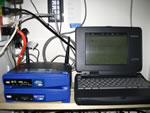 Of course, FireworX-10 is central to my lighting plan. It had been running on my desktop until recently. There are two reasons I changed that. The first is the cost of keeping that desktop running all the time. I don’t know the exact costs of running it but keeping something with a 250+ Watt Power Supply on all the time has to have some measurable cost. The second reason is the aforementioned replacement of that desktop with a notebook. Unlike the desktop, I don’t plan to keep the notebook in the same place all the time so I don’t want the firecracker hanging off of it as I move it around. Also, the docking station that I have does not have a serial port. So, docking the laptop each night would
Of course, FireworX-10 is central to my lighting plan. It had been running on my desktop until recently. There are two reasons I changed that. The first is the cost of keeping that desktop running all the time. I don’t know the exact costs of running it but keeping something with a 250+ Watt Power Supply on all the time has to have some measurable cost. The second reason is the aforementioned replacement of that desktop with a notebook. Unlike the desktop, I don’t plan to keep the notebook in the same place all the time so I don’t want the firecracker hanging off of it as I move it around. Also, the docking station that I have does not have a serial port. So, docking the laptop each night would
not solve the issue.
My solution was put an old laptop back into service. It is a Compaq Aero 4/33 that runs Windows 95. It is so tiny that it fits nicely
into the cabinet. Luckily, FireworX-10 was designed to have low hardware and software requirements and was tested on this very machine so it runs fine on this platform. I had hoped to be able to put it on the network and to remote to is using VNC but I found that VNC does not support Windows 95 running 16 colors. This is all the Aero is capable of. It’s not critical, but, now I have to walk down to administer it. My plan is to someday replace it with a small form factor PC probably of the PIII class in order to keep costs down and still be able to run Windows 2000.
Other
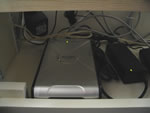 Earlier this year I added NetDisk 80 Gbyte drive. It can attach via USB but it has built in ethernet so it can run standalone. Standalone is the way I have it running. I mainly use it to back up data from my PC. Once backing up my critical data to CDROM started to take two or three disks I decided I needed something better. This was the solution. I use folder clone to do data mirroring. It is pretty stable but I occasionally have problems with it. I originally had it mirroring my whole data directory which is several gigs ever couple hours. This proved to be too aggressive for the software as it would run OK for several weeks and then would stop mirroring and star producing some strange error messages. The fix was to delete the folder it was mirroring to and have it start with nothing on the target. I have backed off and gone to a manual mode for my bulk data backup and have added several scheduled events for my most critical data that run every few days. I figure I can recover from a couple days of data loss and it is far better than my old archive to CDROM which I only did every few months.
Earlier this year I added NetDisk 80 Gbyte drive. It can attach via USB but it has built in ethernet so it can run standalone. Standalone is the way I have it running. I mainly use it to back up data from my PC. Once backing up my critical data to CDROM started to take two or three disks I decided I needed something better. This was the solution. I use folder clone to do data mirroring. It is pretty stable but I occasionally have problems with it. I originally had it mirroring my whole data directory which is several gigs ever couple hours. This proved to be too aggressive for the software as it would run OK for several weeks and then would stop mirroring and star producing some strange error messages. The fix was to delete the folder it was mirroring to and have it start with nothing on the target. I have backed off and gone to a manual mode for my bulk data backup and have added several scheduled events for my most critical data that run every few days. I figure I can recover from a couple days of data loss and it is far better than my old archive to CDROM which I only did every few months.

